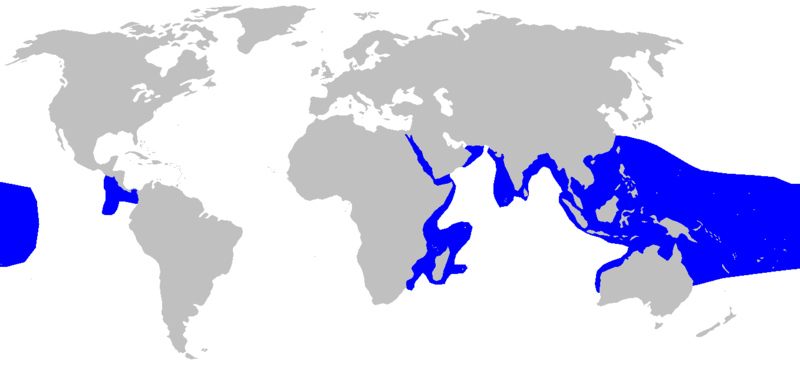Habitat
The white tip reef shark (Triaenodon obesus) can be found in bodies of salt water all over the planet. They live, as their name suggests, primarily in coral reefs and can therefore be found mainly in warm, coastal waters. These areas include the Red Sea, the Indian Ocean along Africa’s east coast, Asia’s southern coast, and Oceania (Education). They can also be found throughout the Pacific Ocean and along the west coast of Central America and northern South America, as well as in the waters surrounding Hawaii where some families believed the sharks to be guardian spirits (Education). The white tip reef shark is considered to be one of the most widely spread of all reef shark species. (Whitney et al., 2012).
The species is nocturnal, meaning most of its activity and hunting are performed at night. During the day the sharks spend their time in caves or beneath coral ledges (Whitney et al., 2012). The same cave can be used by a shark for months or even years and they have a small home range that they do not frequently leave. They are typically found at deeper depths—30 to 35 meters—while the sun is out and at shallower depths—15 to 20 meters—once the sun sets, meaning during hunting and activity. These changes in depth happen quickly at dusk and dawn (Fitzpatrick et al., 2012). Depths vary by geographical location, though, and these sharks have been reported at depths as deep as 330 meters (Education).
Being a reef-dweller, the white tip reef shark shares its habitat with a wide variety of species due to the immense biodiversity of coral reefs. In addition, the white tip reef shark also inhabits a large variety of areas and therefore encounters a large variety of other species. Some other species encountered include other sharks, such as the black tip reef shark (Carcharhinus melanopterus) and the grey reef shark (Carcharhinus amblyrhynchos) with which they compete for food. White tip reef sharks may also come into contact with tiger sharks (Galeocerdo cuvier), which sometimes target them as prey (Education). They also share their habitat with their food source which range from octopi to crustaceans to fish. Some white tip reef sharks, like those close to coasts, also share their habitat with humans. Sharks in tourism areas, such as Hawaii, are especially likely to come into contact with divers who are exploring coral reefs. The species poses no threat to humans, however, and under normal circumstances is known to simply swim away when divers are present. When food is presented the sharks will approach and will eat food from diver’s hand, though this is not recommended as it increases the likelihood of being bitten (Education). However, while they are no threat to us, we are a threat to them. White tip reef sharks are a food source in some places and are therefore fished for and killed for their flesh. Even in areas where they are not the target of fishing, they can still be caught in drift nets where they consequently die (Education). In a study conducted by Nikolas Whitney et al., 9.2% of the sharks observed had injuries that were likely attributed to contact with fisherman. These injuries mostly included imbedded fishhooks, but in one case a broken jaw was observed (Whitney et al., 2012).
| Home | Adaptations |

